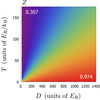
Neutral Atom Optical Clocks Group
Our group researches the fundamental limits of optical atomic clocks based on neutral atoms, as well as their application to quantum sensing, fundamental physics, and precision measurement. This includes the development of ultra-stable laser sources for highly coherent atom-laser interactions. We leverage the extreme precision of optical clock systems to explore fundamental physics, like searches for dark matter and beyond-Standard-Model physics. Using new quantum technologies and the development of a mobile optical clock apparatus, we work to unleash the measurement power of optical clocks for new applications like mapping Earth’s geopotential via relativistic geodesy or re-defining the SI second with next-generation optical standards. Please see below for a more complete list of research projects and activity in our group. We have ongoing research opportunities for students and postdocs. For more information, see the contact information below.
News and Updates
Projects and Programs
Contacts
Group Leader
-
(303) 497-4972








